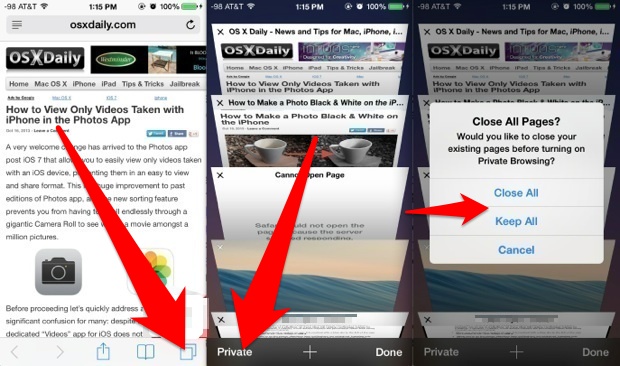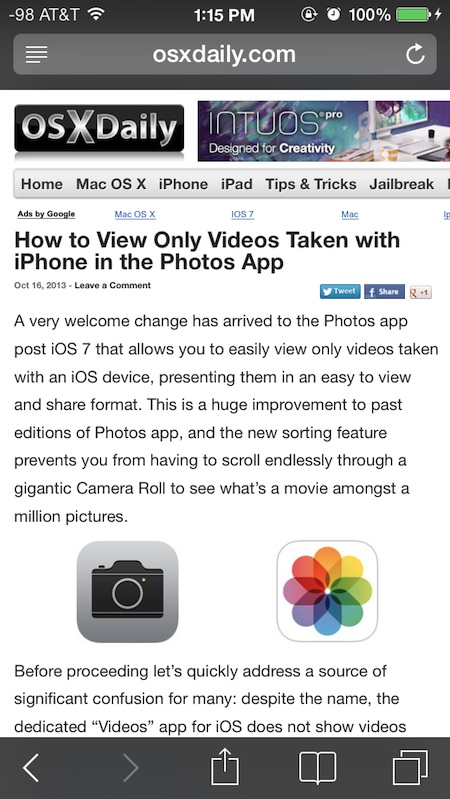How to Use Private Browsing with Safari for iOS 14, iOS 13, 12, 11, 10, 9, etc
![]()
Private Browsing is an optional Safari browsing mode that causes no data from the browsing session to be saved, this means no cache files, cookies, or browsing history will be stored or collected in iOS, making for a fairly anonymous session on the client side.
Using Safari Private Browsing is a popular browsing choice for a wide variety of reasons, and it’s now easier to use on every iPhone, iPad, and iPod touch, because you can now toggle the setting on directly in Safari, and without losing all existing Safari browser pages. This offers considerable improvements over what existed previously, but like much of iOS post the major overhaul, it can be confusing to find until it has been pointed out to you.
Using the Private Browsing option in Safari with iOS 14, iOS 13, iOS 12, iOS 11, iOS 10, iOS 9, iOS 7, and iOS 8 (or newer) is very easy, and the feature works the same on the iPhone, iPad, and iPod touch. This tutorial will demonstrate how to use this great feature.
How to Use Private Browsing on Safari for iPhone & iPad with iOS 14, iOS 13, iOS 12, iOS 11, iOS 10, iOS 9, iOS 8, and iOS 7
You must have a somewhat modern version of iOS to gain access to Private Browsing mode in this way, here’s how it works:
- Open Safari in iOS as usual
- Visit any web page and tap on the URL to make the URL bar and navigation buttons visible
- Tap the panels icon in the corner, which looks like two overlapping squares
- Select the “Private” option to enable private browsing mode, then choose one of two options regarding existing web pages:
- Close All – just as it sounds, closes all existing web page windows, effectively starting a fresh private browsing session while losing all existing panels and tabs
- Keep All – maintain all existing web page windows and panels, turning them into private sessions
- Browse the web as usual, minus any cookies, history, or cache storing

The “Keep All” setting is ideal for most users if you don’t want to lose your prior windows, and if you’re using Private Browsing on someone elses devices to log into an online web service or account it’s probably the most considerate option. The “Close All” option is usually more useful upon exiting Private mode.
Private Browsing is very easy to identify when it’s enabled because the browser window elements turn into a dark grey, both on an individual webpage screen, and on the browser tab panel view.

Keep in mind that entering and exiting out of Private mode will not cause you to lose previously stored cache, history, or cookies, and clearing Safari’s browser data out must be done separately through the Safari Settings options, which also offers an optional site-specific removal setting to delete data for individual websites and domains.
Exiting out of private browsing can be done at any time, repeat the same steps as above but this time tap on the “Private” option again unselect it. You will still have the option to either close all or keep all existing web pages, either of which will switch out of private and back to normal browsing mode.
Users who have prior versions of iOS installed on their iPad or iPhone will find the option exclusively stored in the Settings.


How do I get freq visited icon safari window iphone
The “private” option on my phone isn’t showing up at all
On my 16GB iPod (5th gen but with no rear facing camera) there’s no option to open a private tab. Literally where the Private button should be, there’s nothing.
Your instructions appear to be invalid for iOS 9 on iPad.
These instructions are for all iPhone, iPad, and iPod touch. As long as it is running iOS 10, iOS 9, iOS 8, or iOS 7, you will find Private Browsing Mode works exactly as described above. Easy.
Actually, that’s not how iOS 9+ works at all. I skipped iOS 8, so I know your description of iOS 7 is accurate. On iOS 9, the “private” button no longer shows on the keyboard or the freshly opened page that shows your bookmarks before you actually go to a website.
I would like to know how to convert the websites I already have open into private pages like it did in iOS 7. In iOS 9 you have to click on the double boxes in the upper right hand corner, and it only opens a completely new private window, instead of converting the pages you’re currently on to private windows.
This is how you enter private mode in Safari for iOS 10 and iOS 9, that is how you do it. There is no other way. You can not convert a page to Private Mode without opening it again in a private window.
I to am preparing to learn once again about “private browsing” or “incognito mode” however, I’m a slow learner I need some of the serious questions answered in such away sort of like ” incognito for slower dummies” I get it nonetheless less, I have discovered my phone is being tapped heck they have all the info and how to find out if it is. This I’m sure is not new to us all, it’s quite disturbing thank you for all your technical help and support . Respectfully Carmen . p.s. What app do I get and what is it called to protect any viruses and
Pirateing? Help thank you apple and techs & ur faithfull Apple consumers
Thanx that was very helpful
Thank you so much!!! Been trying to figure this out for weeks!!!
It’s not like that in iOS 7.0.3. On iPad.
Do keep up.
Click on the URL, and the keyboard appears. Hide the keyboard, and you will see “Private” at the lower left corner of your screen. Click it to get the options list,, and click on the option you want.
Click again on “Private” to turn it off.
Actually you don’t have to hide the keyboard on IOS 7.0.4 the private button is on the top left corner of keyboard itself
Thanks Alan, i managed to go back to white top!